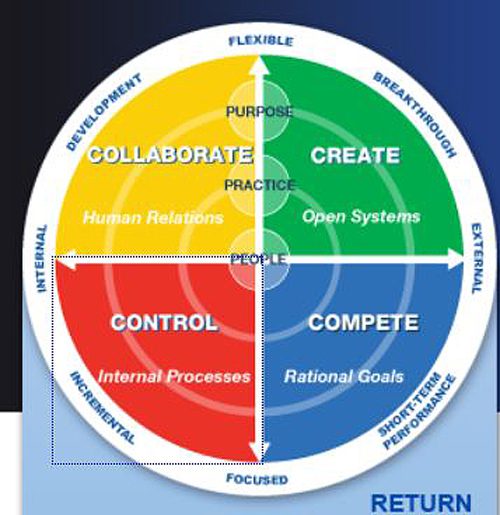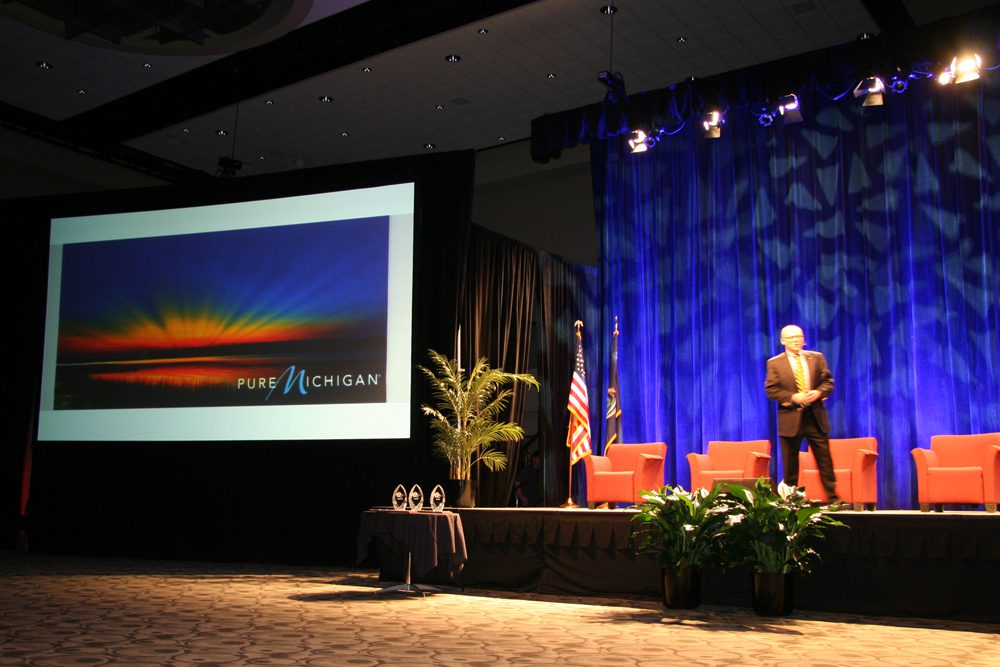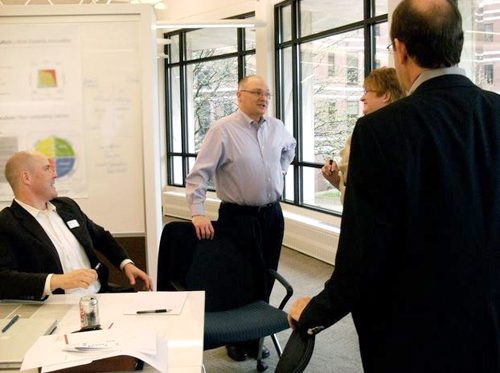

When you ask a university professor a question you should be prepared for an answer that will run 40 minutes and expect to take extensive notes, even if you’re not planning on taking the quiz.
That was what happened when Corp! asked Jeff DeGraff, clinical professor of Management and Organization at the University of Michigan’s Steven M. Ross Business school, how he defines “innovation”.
DeGraff, known as the “dean of innovation” to his private consulting clients such as Coca-Cola, Microsoft, General Electric and Pfizer, as well as to his students in his popular classes at “The Ross,” started off by saying “usually innovation is considered ‘useful novelty.’”
“It’s really just making things better and new,” he simplifies even more. We must be in his 100-level class.
DeGraff got into the innovation analysis business back in the early 1990s when he started developing an “innovation index.” In an approach that was, well, innovative, DeGraff expanded the definition of innovation into four basic forms or competing values. “When I did it, I was considered kooky,” he laughs. “Until I started predicting share prices.” That’s when people started paying attention.
Create
“The first form is what I call the Create form. It’s radical with a lot of risks. The magnitude is high. You’ll see a lot of this in startups, as well as companies beginning to fail.”
Speaking of companies beginning to fail, DeGraff points out that Apple in 1997 was trading at under $5 a share. “When you’re small or you’re dying, the risk and reward are reversed.”
Control
At the other end of the spectrum is the form DeGraff calls Control. He says that the innovations required to succeed – and failure is not an option, he says – are gradual, more a matter of tweaking and process improvement because there are many governmental regulations and standards imposed on the organizations.
Compete
The other two forms are Compete – “which Wall Street loves. This is Goldman Sachs, General Electric, Microsoft. They’re revenue-producing innovators. They innovate to produce very specific goals. The markets within which they operate are often shifting as a result of mergers and takeovers.”
“Innovation is a form of conflict,” DeGraff explains. “The only reason you innovate is to eat – or avoid being eaten. It’s a very Darwinistic form of value.” Thus the mergers and takeovers.
Collaborate
Finally, there are very Collaborative forms of innovation, which is the opposite of compete. “These are the social media, the millennials, universities, zipcar.”
“The compete form is very short term and very performance-driven. The collaborate form is very long-term but very sustainable,” DeGraff explains.
“My claim to fame in the field in general was saying there’s an ecosystem to innovation. When you push on one, you pull on the other. Putting it in another way, everything costs something.
“The more you want ‘much’ the more risk you’re going to take on. The more you want ‘fast’ the less sustainable you’re going to be.
“The classic mistake leaders make is they want one kind of outcome, but they develop the capability and culture of another.”
A favorite example
DeGraff cites a favorite example. “During the Big Recession a lot of the giant tier one companies around Detroit began to falter. Remember, innovation can happen in a down cycle so this was a perfect environment for innovation. But the risk for trying something and the reward for doing it are reversed. When they did that, a lot of them instituted 12-step innovation processes, like going lean [and not what self-help 12-step processes offer]. What they got was efficiency and quality. But – they strangled their radical, breakthrough innovation position. They began to kill themselves. How you innovate is what you innovate.”
 Think of it as a toolkit, he says. “You have a hammer, a wrench and a saw. They’re all good but you can’t use them interchangeably. That’s the biggest mistake senior leaders make. They’ll have a 12-step system and they’ll want radical innovation.”
Think of it as a toolkit, he says. “You have a hammer, a wrench and a saw. They’re all good but you can’t use them interchangeably. That’s the biggest mistake senior leaders make. They’ll have a 12-step system and they’ll want radical innovation.”
But, DeGraff continues, “They’re unwilling to do the things you have to do for radical innovation. These are things like lots of experiments, like venture capitalists do. They accelerate the failure cycle. They diversify the gene pool. They have to speculate.
“Are you willing to take a flyer on that segment you didn’t think you could get into?’” he asks rhetorically. “What happens is a lot of organizations resort back to their old playbook. But a lot of the tools they use are a hundred years old. You can’t build tomorrow’s companies using yesterday’s tools.”
Listening to millennials
This why DeGraff says successful leaders have to listen to young people. “I’ve given TED talks, all that. I’m around a lot of young annoying people in my labs in Ann Arbor and Atlanta. They’re great, they’re brilliant. But they work in an entirely different way. The new tools are apps and they’re on smartphones and on social media and COINS – collaborative open innovation networks.” Things you may never have heard of if you’re over 40.
DeGraff says that global universities “like the one I teach at, have a global footprint. It’s no longer that all the big stuff gets done over here. Now the barriers for entry for innovation are very low. There’s parity in information, so it’s a level playing field. So now we’re living in a world that’s much faster, much more connected, much more seamless.” And much more attuned to those younger innovators.
He talks about how innovation works in the real world and uses Apple and Samsung as examples. “Apple innovates in what amounts to a closed system. Samsung outsells them 4-to-1 yet oversteps the bounds by using intellectual property they may not own.” Yet, DeGraff points out, neither seems to be watching “the largest telecom in the world, ChinaMobile – larger than all of the major U.S. providers combined – uses Lenovo to supply their cellphones.”
“Stay tuned,” he cautions.
Warning signs?
Are there warning signs for organizations that they need to be innovating, and innovating radically?
There are three things, DeGraff says, that they need to look at.
“First, does your organization get stuck in the planning cycle? The plan about the plan. The meeting about the meeting? If that’s the case you can be pretty sure the innovation engine has stalled.
“Second, look at the gene pool. If all the guys – and I mean ‘guys,’ like there are a lot of men and they all look the same, they all think the same – I can almost promise you they’re dead. They want to go to China, maybe get into a different segment – where are those people? They may think they’re diverse but they’re why real diversity is important. If the gene pool is not diverse, you won’t have constructive conflict. You’ll have alignment, which is the death of innovation.”

Third, DeGraff says, is “watch the weather. Are organizations really paying attention to what’s happening outside of their area?” Or, as noted above, sometimes even in that area as with Apple and Samsung. “Nobody expected Apple to get into the music industry, or Tata to get into the automobile industry with a three-stroke engine – nobody’s looking. I get amazed when I talk to executives and they tell me ‘well, you know, I get a briefing but I really don’t like to read because it’s all really negative news…’ I think to myself, we spent decades teaching you how to read!”
He gives another example of the perils of not watching the weather. “I’m on my two-millionth mile on Delta and I’m coming back from Miami. A woman is sitting next to me and she’s obviously well-to-do. She tells me she got blown out on some condos she had, and how hard she had worked to get them. I didn’t tell her how I’d been an adviser to the Federal Reserve back in ’05 and ’06. I asked if she hadn’t gotten a sense that the market was getting soft. She said, ‘I don’t read the paper, I don’t watch the news. It’s all negative.’”
Positive paranoia
“I think Andy Grove had it right. There’s a bit of paranoia that you have to have to be any good at this. When things are going well you can’t stop looking [at the weather.]”
Small business innovation?
What about small businesses, DeGraff is asked? They usually have been innovative to get where they are – they’ve done something better or something that hasn’t been done at all – so do they have to learn how to be innovative all over again?
“They don’t. For a small business to survive there are only two things it can do: it can maintain, meaning someone in this generation or the last was an entrepreneur and they’re trying to save the fortune they’ve made. They built a furniture company or one that makes axles, and the rest of the family is about maintaining those contracts. Those firms will always be $50 million, they’ll never get bigger, ever.”
“Other firms will have to innovate to get bigger because they can’t compete on scope or scale; they haven’t the resources for it. So necessity is indeed the mother of invention [or innovation.] The problem with those small firms is not about their ability to innovate or grow, it’s to build sustainable infrastructure under them to get to scale. Going back to my four types of innovation, theirs is all about diverging. It’s selling more things to different people.”
Domino’s – the pizza chain
DeGraff recounts how he was an executive member at Domino’s Pizza not long after Tom Monahan had come out of Chapter 11. “What I learned was that most small businesses don’t know to grow very well. But what Tom did was take a franchisee and make him be an apprentice for a year under a franchisee who knew the way. We called it the MIT program – the Manager In Training program. The company would then float you the money for your first store.

“Tom understood two things. In order to make a business work you have to have some real life experience in building one. That’s why there are serial entrepreneurs. You learn a few things. The second thing he knew was there has to be a pathway to grow. That’s what the prospective franchisees didn’t know how to do. That’s where the seed money came in, the replicable system came in and it’s why it grew so fast. When they got away from that and just started having investors there were so many challenges in getting an investor up to speed. (For more on how one Domino’s franchisee has grown from delivering pizzas to owning forty stores.)
Small companies have to innovate, it’s in their DNA, DeGraff says.
Four things necessary for successful innovation
“You have to have high-quality targets. It can’t be a Really Big Thing [think multi-billion dollar buyouts or IPOs] or a ‘tweaking the system’ thing. A high-quality target is something that’s a little bit beyond your reach. You think you can be at the right place, at the right time, with the right thing.
“You need deep and diverse domain experts. Innovation is not an amateur sport. I was talking to a couple of reporters in Silicon Valley and they were talking to me about Google (and remember Larry Page was one of our students here at the University of Michigan). They were saying that, ‘you know, Google was created in a garage by amateurs.’ I just laughed and said that Serge and Larry were PhD candidates at Stanford in the information science department – you couldn’t be farther from an amateur if you tried.
“You need people who really know the field back and forth – but they don’t agree. So if you’re building something, say, that will look through ocean shipping containers, you need someone who’s an expert in thermography and one who’s an expert in metallurgy and like that. You put them in a room and have a process to get them to work together. Remember, it’s not like Washington where you have Republicans and Democrats trying to kill each other. It’s putting people in the room who don’t agree who are trying to get to a higher order solution. A hybrid, something no one else has thought of.
“The third piece is: learn from the venture capitalists. Take multiple shots on goal. Venture capitalists don’t give one startup $100 million, they give 10 startups $10 million. They’re all trying to find a therapy for the same disease – but the VC is trying to accelerate the failure cycle. So they give less money and less time to turn over the portfolio to see what works and what doesn’t. It’s never the one you think that’s going to work that does. It’s always the nag that runs in the rain, right?
“The final thing is you have to learn from your experience and your experiments. I’m always amazed at organizations that run all these experiments and never get any smarter. You have to figure out what works and what doesn’t. You have to stop some things, you have to start some things, you have to hold some things. You have to develop some simple rules from those discoveries: ‘we can’t launch during the busy season’ or ‘this is outside of our pale – we don’t have the capability to do this’ – whatever.”
The bell rings, signaling the end of the class. DeGraff has a final summation: “Innovation is a cycle, a highly iterative process. Nobody gets it right the first time. There is no effortless superiority.”
Quiz is next week.







